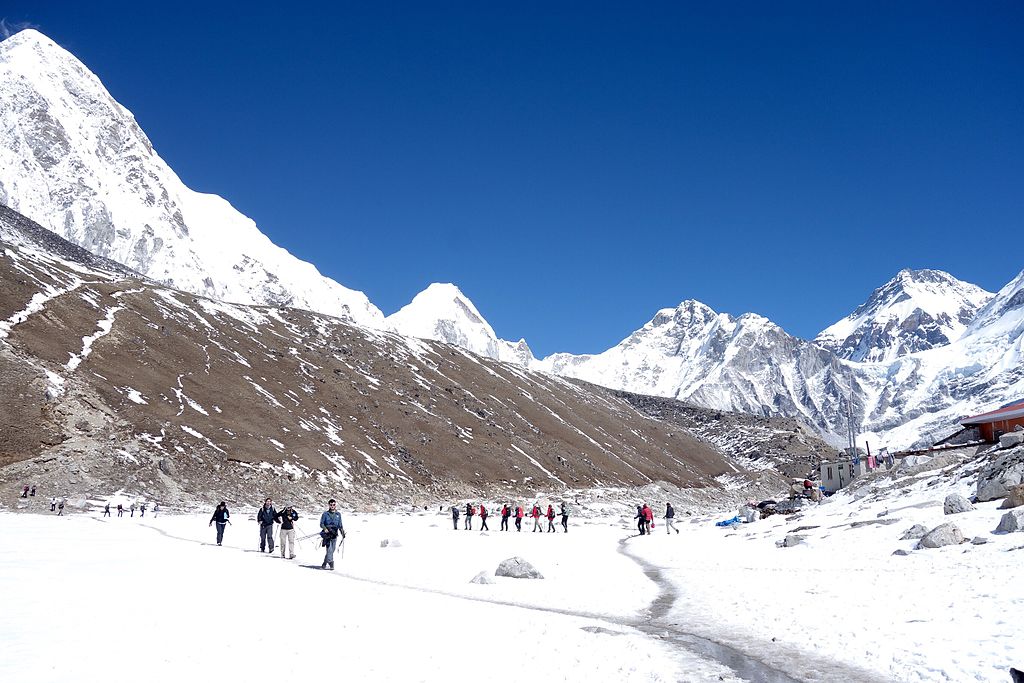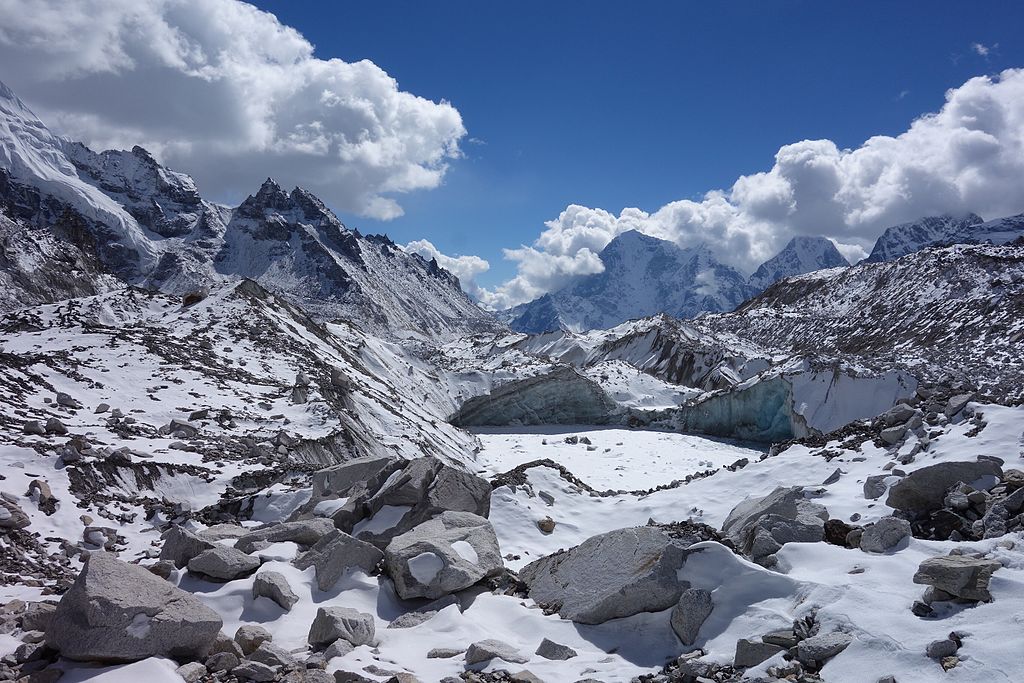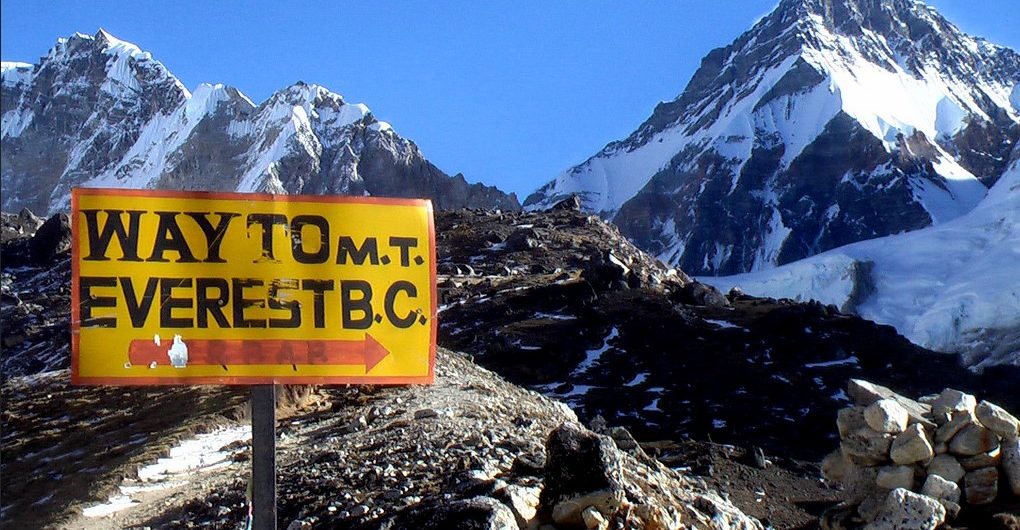Mount Everest Base Camp Trek is the best trekking journey to the iconic highest peak of the world and is a once in a lifetime trekking journey to the nearest point of the highest point of the earth. It is the most thrilling and adventurous trekking journey in the whole world. This trek has been covered by most of the trekking lovers and trekkers from the different parts of the world.
The Everest base camp is the gateway to reach the Mount Everest, the highest peak of the world to everyone who wants to climb the highest peak. This trekking trail is famous for trekking which holds a very long history of glory and pride along with various tragedy too.

This trekking journey is the dream for millions of trekking lovers around the world. Every trekking enthusiast wishes to go for Everest Base Camp trek at least once in a lifetime. This trekking journey passes through the magnificent views of green vegetation, Himalaya series, beautiful local Sherpa village and tradition of Nepal. You will also learn about the amazing and friendly Sherpa people who are well known in the whole world for their capabilities of climbing.
The major excitement of this trekking adventure begins once when the flight to Lukla takes off. The wonderful feeling of visiting the highest peak of the earth itself is a great feeling which cannot be compared with anything else. The amazing passes through the beautiful hills, lush green forests, and the beautiful Khumbu glacier. This trekking journey provides the most amazing feeling that stays fresh in your memory for your whole life.
Let’s learn about some basic questions related to the Mount Everest Base camp trek.
1. What is the total height of Everest Base camp?
Ans. The Mount Everest base camp is 5364 meters from the southern side while it is 5545 meters high from the northern Tibetan side.
2. What is the height of Mount Everest from sea level?
Ans. Mount Everest stands 8848 meters above the sea level as per the official measurement as taken by Nepali and the Chinese government.
3. What is the weather condition at Everest Base camp?
Ans. As Everest Base Camp is located at very high in the mountainous region of Nepal, the temperature around the base camp is quite low and snowfall occurs quite often.
The altitude increases by 4000 meters after leaving from Kathmandu while going to Everest Basecamp, hence the changes in temperature would is quite normal with the increase in altitude. The higher you reach, the less temperature would you feel and the weather goes more unpredictable.
The temperature variations are given below during different seasons:
- Summer – The summer season at Everest Base Camp starts from June and ends by August. The temperature around the region is 0-degree centigrade during summer. But since the monsoon coincides with Summer, hence it is not so popular season for trekking.
- Winter – Winter starts from December and goes till February and the temperature reaches somewhere too – 20-degree centigrade. Trekking in this season not so popular because of the cold weather.
- Autumn – The Autumn season falls between September to November and the temperature is very pleasant during this season with quite fewer chances of rainfall. The temperature goes mild in this season and it is the best time to trek to the Everest Base camp.
- Spring – Spring season starts once the chilling cold winter ends. Spring season starts in March and end by May. The environment in this region gets beautiful with green vegetation and lushly rhododendron flowers blooming.
4. Can I trek if I have zero trekking experience?
Of course, you can, if you are physically and mentally fit. The experience doesn’t matter if one is determined to leave their comfort zone and experience this once in a lifetime journey.
5. How difficult is it to trek to Everest base camp?
Everest base camp is the most popular trekking trail in the entire world and an adventure of once in a lifetime. So, the difficulty of the journey should not matter much for those who are confident and determined to complete this trekking getting out of their comfort zone.
And if we talk about the Mount Everest base camp area, the path is not paved and is not like the regular road we walk. The trekking trail is rocky, rough, and graveled. Most of the time one has to walk for the longer duration within ups and down trails. Also, depending on the season and weather situation, one can witness the snow falls on the trek route. This is not an impossible and very hard trek if you are confident and wish to complete it leaving your comfort zone.
6. What preparations do I need to do for Mount Everest Base Camp Trek?
Talking about physical fitness, Everest Base Camp isn’t for people with weak joints, knee, lungs or heart problems and we recommend you to according to your physician’s advice in such cases.
Also, this trekking journey has been completed by the children of an early age to the people over 70 without much difficulty. Hence, it does not matter how the difficult is to climb to the base camp, the itinerary designed by Nature Trails is so efficient that the walks are medium and attainable by every age group.
But yes, the trek to base camp is not as simple as roaming in some park or any other random treks; there are various ups and downs. Hence, before going for this trek, one need to train themselves with some regular walking and jogging carrying the total weight they are planning to take on their trekking trip.
7. What type of food and accommodation one get on Trekking journey?
There are numerous Tea houses and best class lodges on the way to Everest Basecamp. Almost, every tea house one the trekking route has the menu options similar to the food menu of a regular restaurant in Kathmandu.
Getting non-veg food beyond the Namche Bazaar is a bit difficult, and is quite rare unless you are staying in a luxury lodge. The reason behind shortage of meat is, it becomes hard to keep the meat fresh and also the price is so high at the altitude. But, one can easily afford a steak even in the most popular season.
And the most famous food on the trekking journey is Dal Bhat. Dal Bhat is a combination of rice, lentils, vegetables and vegetable curry. It is served in massive portions and is enough to everyone with large hiking appetites. Also, it is the national dish of Nepal.
Note: We recommend you to drink bottled water on during the trekking journey. It is available throughout the trek route. Please do not drink local tap water as you may suffer a bad stomach which may result in the hindrance to your trekking expedition.
8. Can I get my own food on the trekking journey?
You can get every type of foods that you wish to have on the trekking route but if you want to have some specific, then it’s upon your wish.
But we recommend you not to carry many foods as it will be heavy and increase your backpack weight which can be an issue while walking. You can keep chocolates and energy bar which are the perfect dosage of energy and sudden relief from hunger.

9. What about Altitude Sickness on Everest Base Camp?
The oxygen level decreases with the increase in elevation, which results in various health issues to most of the people. One of the common issue most of the people face on the trekking journey to Everest Base Camp trek is the altitude sickness.
One needs to be physically and mentally prepared to get rid of the altitude sickness,. Plus, one should take slow and small steps while walking up and down on the trek route and make sure your body is getting enough nutrition.
To prevent the altitude sickness, one needs to take proper medication, proper sanitation and have the nutritious and right amount of diet every day.
10. Is Guide mandatory for Everest Base Camp Trek?
Guides can be helpful to you in different ways during your trekking tour. The most important help they provide besides assisting you on the trek route is by helping you to understand and know the local culture and community.
You could even hire a porter along with the guide. A porter will carry your goods giving your back rest on the entire trekking journey. This will boost your trekking performance and help you to finish the trek on time.
Additionally, you can also hire a porter cum guide who will carry your possessions along with assisting you on the trekking expedition.
If you have trekked several times to Everest Base Camp, you could be excited to visit base camp without a guide. We understand that with multiple trekking experiences, you can for sure do that. But having a guide beside you in an unknown place in the mountains is always a better idea.
Plus, the Nepal Government is soon going to make the hiring of guide compulsory on trekking routes due to the disappearance of many solo trekkers.
12. Do I require a travel insurance to go to Everest Base Camp trek?
No matter where are you traveling, hiking or trekking, a travel insurance will assure you to be safe about the various things which may go wrong. There are numerous problems one can face while trekking. Some of the common problems are altitude sickness, injuries, sickness etc. An insurance will always be helpful to cover up expenses for these random issues.
At the worst case, you might be down with altitude sickness while hiking and need to rescue you via airways which would cost you up to 5000 USD.
Having a travel insurance on EBC trek will help you to be safe from such issues. There are a number of travel companies which provides travel insurance coverage for the base camp trek. You need to be sure and check the list of things covered at the travel insurance coverage you select. Also, the insurance is helpful to many travelers who lose their personal belongings and luggage because of theft. A travel insurance always helps you cover up the expenses which may go wrong during your journey.
13. Which is the best time to go for the Everest Base Camp trek?
The best time to go for EBC trek is in summer from April to mid-June, spring and summer fall from September to November. It is the best time to go for Everest Base Camp trek and enjoy the Earth highest summit along with its neighboring Himalayas range.
Travelers from various parts of the world come to climb to EBC throughout winter (December until February) in spite of the chilling cold and low temperature. They feel happy to enjoy the beautiful weather and amazing mountain views in the afternoon time. Also, many people come for the trek in winter because of the less crowd.
Winter is also a good time to go for this incredible trekking trip if you can prepare for the chilling cold and snowfall during the winter season. You can enjoy the fantastic panoramic view of Everest and the various other Himalayas covered with the white layer of snow during the day time.
We provide custom packages for Everest Base camp trek based on trekkers requirements. Please contact us if you want any special package for your group for Everest Base Camp trek.
14. What do I need to carry for the Everest Base Camp trek?
You must have the trekking permit and also need to pay the National park entrance fees and TIMS card which is easily available at every travel agencies or you can get them from Nepal Tourism Board office.
The major packing for the trekking depends upon the season you are going trekking to Everest Base Camp. These are the basic requirements and one should have during the trekking journey:
- A well-documented map
- A warm jacket to prevent you from cold
- Long sleeve t-shirts
- Shorts
- Trekking pants
- Good quality trekking boots
- Good quality socks to accompany the boots
- Hat
- Towel
- Water purification system
- Sandals
- Tight sealed and heat proof water bottle

15. What is the cost of Everest Base Camp Trek?
The 14 days amazing and exciting Everest Base Camp Trek by Nature Trail cost ranges start from 1015 USD with discount. We also have custom packages if you have your own group. You can directly get in touch with us by mailing your queries at “[email protected]” for detailed information about costs and various other information related to the Everest Base Camp trek.
The 14-day itinerary of th Everest Base Camp trek is given below:
Day 1: Arrive at Kathmandu and trip preparation (1370m)
Day 2: Fly to Lukla and trek to Phakding (2610m) – 4 hrs walk
Day 3: Trek to Namche Bazaar (3440m) – 5 hrs walk
Day 4: Acclimatization day at Namche Bazaar
Day 5: Trekking to Tengboche (3860m) – 4 hrs walk
Day 6: Trek to Dingboche from Tengboche (4410m) – 5 hrs walk
Day 7: Rest at Dingboche or trek to Chhukung (4730m)
Day 8: Trekking to Lobuche (4910m) – 5 hrs walk
Day 9: Hike to Kala Gorak Shep (5140m) and walk to Everest Base Camp (5364 m) – approx. 8 hrs walk
Day 10: Trek to Kala Patthar (5545m) and descend to Pheriche (4240m) – approx. 8 hrs
Day 11: Trek from Pheriche to Namche Bazaar (3400m) – approx. 7 hrs walk
Day 12: Descend to Lukla (2840m) – 7 hrs walk
Day 13: Fly back to Kathmandu
Day 16: Fly back to Home or Extend your trip
Also Read,
-
Top 10 Trekking Routes of Nepal
-
Top 10 Places to Visit in Nepal
-
12 Unique Things only found in Nepal
We hope you like our Everest Base camp trek guide. If you have any question or queries about the trip or any other travel related question, feel free to ask us via the comment box below or direct mail at [email protected]. We will be happy to assist you for your trip to Nepal.


Comments